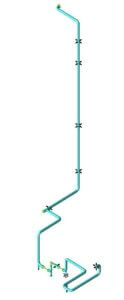Introduction
In a wash oil line, undesirable vibrations are observed in the downstream line of an angle control valve.
Upstream of the control valve, the wash oil has a pressure of 150 bar and a temperature of 400C. Downstream of the valve the pressure dropped to 9 bar, and the temperature remained at
400C. The vapor/gas content was 2% of the total mass flow at these conditions. DRG was requested to investigate and minimize the vibrations in the system.
Analysis
It was found that the vibration level was increasing with an increasing flow rate. To gain a better insight into the possible cause of the vibrations, dynamic stresses and remedial actions to be taken, a computer model was made of the system under investigation to determine the most likely excitation mechanism. This mechanism was used to assess the dynamic loads that could be expected in the existing situation.

The vibration levels predicted by the initial model, and the most likely excitation mechanism, matched the observed vibrations very well. To get more accurate results the model needed to be tuned using data from performed vibration measurements.
Results
- The highest stress in the system under investigation occurred in the tee.
- A desired mass flow rate increase to 5700 tonne/day would lead to an expected fatigue life of 6 years.
- When the mass flow of 4900 tonne/day would be increased in the future, it was recommended to modify the pipe supporting arrangement.
“The supporting in the model was modified to improve the dynamic piping response.”
The support in the model was modified to improve the dynamic piping response. With the modified support arrangement in place, the results showed a considerable improvement in the vibration level for the same excitation mechanism.







